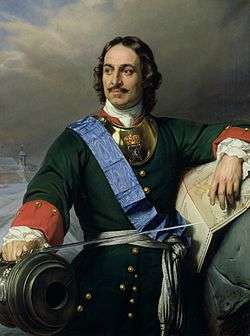Treaty of Narva
| Type | alliance |
|---|---|
| Signed | 30 August 1704 |
| Location | Narva |
| Parties |
Tsardom of Russia Polish-Lithuanian Commonwealth (Sandomierz Confederation) |
| Language | Russian |
The Treaty of Narva was concluded on 19 August (O.S.) / 30 August 1704 during the Great Northern War.[1] The faction of the Polish-Lithuanian Commonwealth loyal to Augustus the Strong joined the anti-Swedish alliance between the Saxon electorate and the Tsardom of Russia.[1]
Background
At the onset of the Great Northern War, Augustus the Strong was king of Poland, Grand Duke of Lithuania and Elector of Saxony.[2] In 1699, he allied with the Russian tsar Peter the Great in the Treaty of Preobrazhenskoye and with Frederik IV of Denmark-Norway in the Treaty of Dresden.[3] The alliances provided the basis for a combined attack on the Swedish Empire, which followed in 1700.[4] Already in 1700, Denmark was forced to withdraw[4] and Russia suffered a decisive defeat.[5] In the following years, Charles XII of Sweden pursued Augustus through Poland-Lithuania, imposing on him a series of defeats, and Russia was able to recover and advance in the Baltic provinces.[5] The Lithuanian magnates abandoned Augustus in April 1702 and allied with Sweden.[6]
In July 1704, Swedish advances and the resulting internal quarrels in Poland-Lithuania caused the dethronement of Augustus the Strong and election of Stanisław Leszczyński, the candidate promoted by the Charles XII of Sweden, as the Polish king.[1][7] However, Augustus the Strong still enjoyed support in the Polish-Lithuanian Commonwealth, particularly by the Sandomierz Confederation and about 75% of the Polish army.[8] In the name of the commonwealth, Augustus and his supporters declared war on Sweden and joined the anti-Swedish coalition at Narva.[8]
Terms
The treaty was negotiated for Poland by Thomas Dzialynski (Dzialin),[9] a commander of the Saxo-Polish forces participating in the preceding Russian siege and storm of Narva.[10] The treaty was signed by Peter the Great of Russia, Augustus the Strong and Polish-Lithuanian magnates.[1]
The alliance was both defensive and offensive.[1] The treaty ruled that Poland and Russia were both to continue the war and to sign no treaties without mutual consent.[11] Peter the Great was to grant August the Strong 200,000 rubles annual subsidies,[12] maintain 12,000 troops, and return Semen Paliy's conquests in Ukraine and Russian conquests in Livonia.[11]
Consequences
Peter the Great had thus ensured that the Polish-Lithuanian theatre would continue to bind Swedish forces.[9][13] Most notably, enforcements for Charles XII's Russian campaign were cut off in the Battle of Koniecpol.[14] To pay the agreed on subsidies, a monetary tax was raised from the peasantry.[15]
For Augustus, the treaty was favourable, as his position had deteriorated from his numerous defeats by Swedish armies.[9] Peter the Great, in pursuit of the treaty, ordered Ivan Mazepa to expel Paliy (Paley) from the commonwealth's cossack territories, which he eventually did, Dzialinsky's irrefutable condition during the negotiations.[9][16] However, Russian "helpful occupation" of Livonia would result not in the anticipated handover but instead in integration into the Russian Empire.[10][16]
The faction of the Polish-Lithuanian Commonwealth loyal to Stanisław Leszczyński, organised in the Warsaw Confederation, instead concluded an alliance with the Swedish Empire in the Treaty of Warsaw in November 1705.[16]
Sources
References
- 1 2 3 4 5 Donnert & Mühlpfort (1997), p. 512
- ↑ Frost (2000), p. 227
- ↑ Frost (2000), p. 228
- 1 2 Frost (2000), p. 229
- 1 2 Frost (2000), p. 230
- ↑ Frost (2000), p. 265
- ↑ Frost (2000), pp. 267-268
- 1 2 Frost (2000), p. 268
- 1 2 3 4 Bromley (1970), p. 699
- 1 2 Wróbel (1996), p. 374
- 1 2 Schuyler (2004 reprint), p. 28
- ↑ Schuyler (2004 reprint), p. 29
- ↑ Frost (2000), pp. 269-270
- ↑ Frost (2000), p. 270
- ↑ Anisimov (1993), p. 104
- 1 2 3 Frost (2000), p. 269
Bibliography
- Anisimov, Evgeniĭ Viktorovich (1993). The reforms of Peter the Great. Progress through coercion in Russia. The New Russian history. M.E. Sharpe. ISBN 1-56324-047-5.
- Bromley, J. S. (1970). Rise of Great Britain & Russia, 1688-1725. The New Cambridge Modern History. 6. CUP Archive. ISBN 0-521-07524-6.
- Donnert, Erich; Mühlpfordt, Günter (1997). Europa in der Frühen Neuzeit: Festschrift für Günter Mühlpfordt. Aufbruch zur Moderne (in German). 3. Böhlau. ISBN 3-412-00697-1.
- Frost, Robert I (2000). The Northern Wars. War, State and Society in Northeastern Europe 1558-1721. Harlow: Longman. ISBN 978-0-582-06429-4.
- Schuyler, Eugene (2004). Peter the Great. 2 (reprint ed.). Kessinger Publishing. ISBN 1-4179-7143-6.
- Wróbel, Piotr; Kozicki, Richard J., eds. (1996). Historical dictionary of Poland, 966-1945. Greenwood Publishing Group. ISBN 0-313-26007-9.

